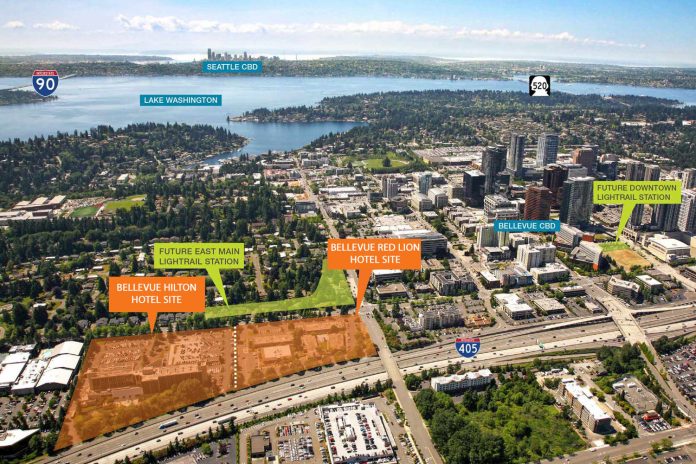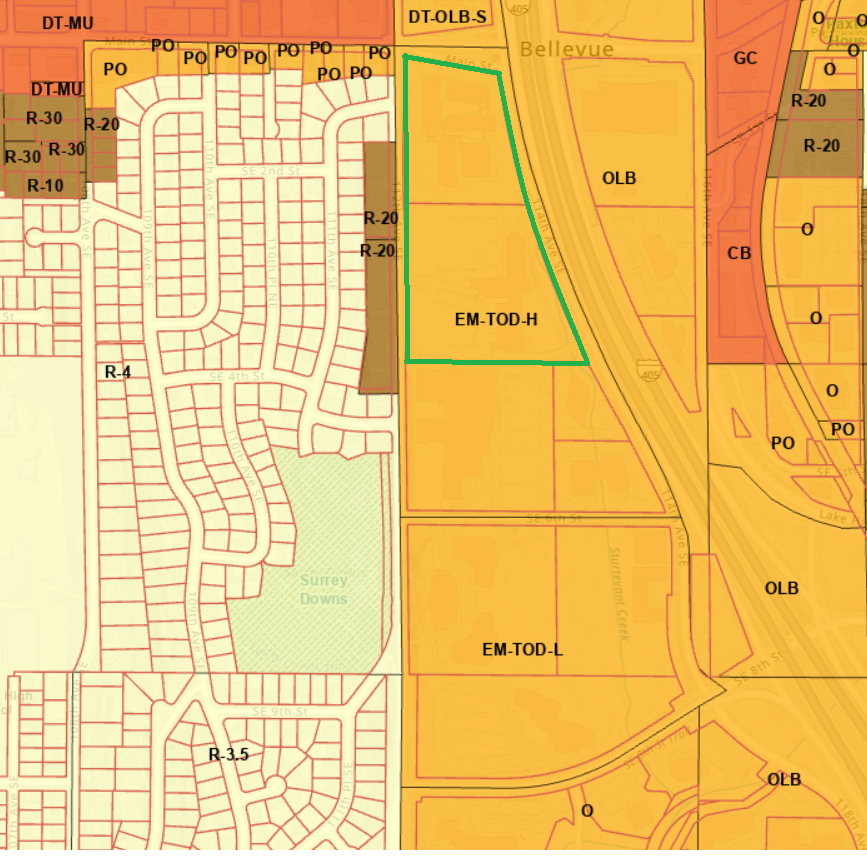
Pacific Northwest developer Wig Properties recently announced plans to redevelop two parcels near the future East Main light rail station. Currently home to the Bellevue Red Lion and Hilton hotels near I-405, the 15.5 acre site will feature six towers, each up to 38 stories tall, with 1.9 million square feet of office space, 270,000 square feet of retail space, 340 hotel rooms, and 1,350 housing units. A pedestrian bridge over five-lane 112th Avenue SE will connect the site with East Main Station and will supplement three at-grade crossings at Main Street, SE 300 Block, and SE 6th Street.
This announcement comes on the heels of recent work by Bellevue City Council to rezone the area to the east of the light rail station for more intensive uses. Months of Council discussions, staff work, and public outreach culminated in a December vote to establish two new zoning designations for the East Main site. Among other items, the vote set maximum building heights and Floor Area Ratios (FAR), designated certain public amenities, and block sizes — all work that defined the character of this redevelopment proposal.

Slightly Less Housing than Expected
Back in December, staff estimated that their regulations would help create approximately 1,500 units of housing on the site, with a little under 90 of those units being affordable to households making 80% Area Median Income (AMI). The final proposal from Wig Properties will come in approximately 10% under that expected total, but this still represents a significant increase from the requirements the company lobbied for during the rezone process.
In a September meeting, Wig Properties pushed for (and conservative councilmembers supported) regulations that would have only required the company build approximately 865 housing units across the site. At other junctures, the company also lobbied for FAR regulations that would have removed incentives to build housing units. Instead, Wig Properties sought policy language to allow for higher building heights and increased allowances for commercial development. With Bellevue’s significant housing deficit, it’s encouraging that regulations mandating minimum housing development did not prove to be unprofitable for developers, despite repeated fears from conservative councilmembers.
Public Amenities
However, Council did relent to the developer’s request to add a pedestrian bridge onto the list of acceptable public amenities, which is likely why one is included in this proposal. Staff had structured public amenities (i.e. items developers could build in exchange for increased heights and FAR) into a two-tier system, with Tier One amenities required to comprise three-quarters of the public benefit developers provide. An initial list from staff saw only four items in Tier One: public spaces, new streets, affordable housing, and childcare facilities. Although this would not give developers much choice in what to provide, it would ensure that the City was getting one of these high-priority benefits. Staff were therefore reticent to add more benefit types to Tier One, because they did not want to dilute the provision of what had been understood as key Council priorities.
Mayor Lynne Robinson voted with the conservatives in moving a pedestrian bridge into the Tier One amenities group. This was admittedly only one vote in a flurry of motions that saw the attempted additions of performing arts facilities, public art, and mom and pop shops to the prioritized Tier One pool. Each vote ultimately reflected the desires of different councilmembers and what they were willing to prioritize at the potential expense of another amenity. However, since the purported safety benefits of pedestrian bridges can be obtained through traffic calming, policy, and improved street design, it’s unfortunately easy to imagine how a different, more useful amenity could have been provided in its place.
One Final Note on Parking
Square footage and housing unit numbers weren’t the only figures from the developer’s announcement that made some eyes pop. The inclusion of 2900 parking stalls seemed excessive to many (myself included) for a site that is immediately adjacent to a light rail station. However, further review shows that this figure is actually low by Bellevue standards for a project of this size and scope. To loosely confirm this, I reviewed all major development projects listed across the City’s Q1 reports for BelRed and Downtown and ran a multiple linear regression model to determine the relationship between square footage across different uses and the number of parking stalls a project incorporated. Although certainly not the most statistically rigorous analysis, it was still surprising to see that the East Main project has less than half the parking stalls that a Bellevue development of its size “should” have.

There’s of course still an argument to be made that nearly 3,000 parking spaces near a light rail station represents a high figure, even if it’s lower than that of other projects in the city. Since rezone discussions did not look at parking requirements explicitly, it’s unclear just how much wiggle room was available to Wig Properties in their selection of this figure. However, with the parking stalls located underground, hopefully their presence will not prevent the new development from being a dense, walkable, and vibrant new urban core for Bellevue.
Chris Randels is the founder and director of Complete Streets Bellevue, an advocacy organization looking to make it easier for people to get around Bellevue without a car. Chris lived in the Lake Hills neighborhood for nearly a decade and cares about reducing emissions and improving safety in the Eastside's largest city.

